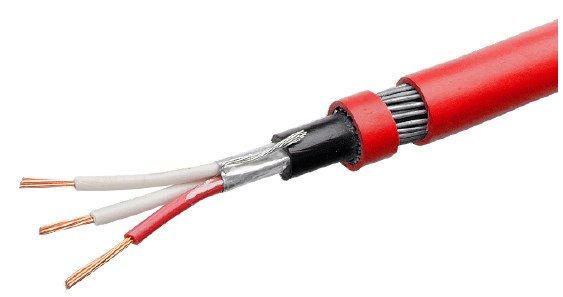- Home
- About
- Products
- Contact Temperature Sensors
- Cables & Wires
- Mineral Insulated Cables
- Nickel & Thermocouple Alloy
- Industrial Heaters
- Heating Cables and Mats
- Non Contact Temperature Sensors
- Industrial and R&D Furnaces
- Temperature Calibrators
-
Circulating Chiller
- Services
-
Special Products
- Thermal Profiling System
- Industries
- Resources
- Contact Us
- Shop
Fire Resistant/ Survival Cable
In buildings (like hospitals, shopping malls, etc.), public utilities (like metros, railways, etc.) and power or energy sector, manufacturing plants where people are in more numbers, vital circuits are required to continue operations it becomes very essential that in case of fire breakout or short circuits resulting into the fire, applications such as emergency lighting system, elevators, fire alarms, water sprinklers, pumps, etc continue their working and the cables powering these need to sustain fire for a definite period of time and Fire survival cables are the ones that meet this requirement.
For making the cable safe from fire, we improve the properties of cable insulation & jacket and try and ensure self-extinguishing compounds, which even if there is external fire, they will not propagate the flames and remains the power supply under fire condition for a certain time.
We have talked about insulations/jacketing so which is better whether we go for Heat Resistant Poly Vinyl Chloride, Polyethylene, XLPE or Silicon let’s talk about each one of them and their features
PVC – Heat Resistant Poly Vinyl Chloride which has got excellent electrical insulating properties or dielectric strength but due to the presence of chloride it has got a drawback that is on decomposition it emits halogen gas bad for the environment .
PE- Polyethylene has got poor fire resistance properties but adding certain fillers of both halogenated and halogen free its fire resistance can be improved significantly.
XLPE - Cross-linked polyethylene which is an upgraded version of PE has got good fire resistance properties and can withstand up to 90°C when compared with PE's 75°C.
Silicon - Best option for the characteristics that it provides working temperature range upto 200°C and as low as -90°C and because of its mineral nature it is also LSZH and additional features of oil and solvent resistance, and good corona, and ozone and weathering resistance.
Tempsens provides Fire Survival Cables with the following specifications
- Voltage Rating: 600 / 1000V
- Operating Temperature: -40°C to + 90°C
- Conductor: Electrolytic Grade Bare Copper/Tinned Copper
- Fire Resist Heat Barrier: Mica Heat Barrier Tape
- Insulation: XLPE/ SILICON/EPR
- Screening: Al-Mylar/Mesh braided (if required)
- Inner/Outer Sheath: Halogen Free Low Smoke Polymeric compound.
- Armoring: G.I. Round Wire / G.I. Flat Strip or Stainless Steel Braiding
- Reference Standards : IEC 60331, IEC 60332, IEC 60754, BS 7846 ,BS 6387, EN 50290-2-27, EN 50288-7, BS7655, BS 7629-1, IS7098,IS9968, IS 6380, IS 3675, IEC 60502

Specific Requirements for Fire Survival Cable:
The cables shall have circuit integrity as per IEC 60331
- Primary insulation shall be heat resisting elastomeric which can withstand temperature up to 90°C such as silicon rubber/mica glass tape/EPR (medium grade) as per IS 6380. Insulation thickness shall be as per IEC 60502-1
- Individual pair triad shall be shielded. The shield shall be aluminum backed by mylar/PETP tape with the metallic side down helically applied with a 25% overlap on either side and 100% coverage.
- Inner and outer sheath shall be made of low smoke, halogen-free, heat resistant, oil resistant and flame retardant material with oxygen index over 30, temperature index shall be over 250°C. Acid generation shall be a maximum 0.5% by weight as per IEC 60754. Smoke density rating not to exceed 20% as per ASTM D 2843
- The thickness of the sheath shall be as per IEC 60502. Inner and outer sheath colour shall be Orange or red. A rip cord shall be provided for inner sheath.
Tempsens is having in-house test facility as per BS 7846 except few tests, which can be performed at External Lab (Type Test Report available) as follows:
- Resistance to Fire alone (Protocol C)
- Resistance to Fire with Water (Protocol W)
- Resistance to Fire with Mechanical Shock (Protocol Z)


